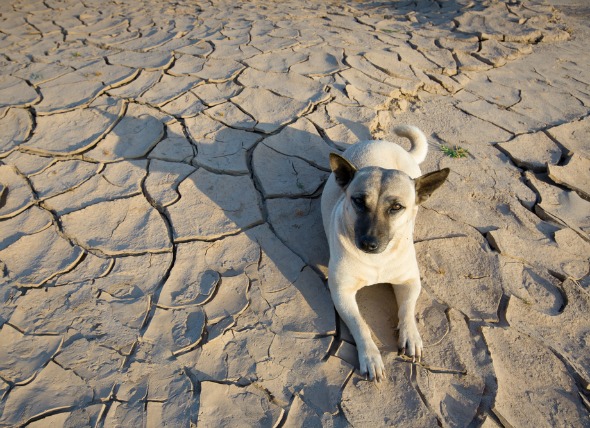

Mycosis is the medical term for any disorder caused by a fungus. Coccidioidomycosis comes from inhalation of a soil-borne fungus which normally affects the dog's respiratory system. However, it is known (even likely) to spread out into other body systems.
The fungus spores begin in the lungs as round spherules, and live in a parasitic stage in the lungs until they grow large enough to rupture, releasing hundreds of endospores, which then begin a parasitic stage in the tissues, growing and rupturing, spreading out (disseminating) into the body perpetually. Endospores can also take a faster route through the body by way of the lymphatic and blood vessel systems, resulting in systemic infection -- meaning the entire body will be affected. Coccidioidomycosis sets in from 7 to 20 days after exposure, though some dogs can develop immunity and never show any symptoms, especially younger dogs.
Dogs that are susceptible to the infection can become ill from only a small amount of the Coccidioides fungus, and fewer than 10 fungus spores are needed to cause the disorder. And though uncommon, Coccidioidomycosis is a deadly disease that originates mainly in the arid, hot regions of the western and southwestern regions of the U.S., and in several Central and South American countries. Coccidioidomycosis affects many different types of mammals, but tends to occur more commonly in dogs than cats. This infection is also known as valley fever, California fever, Cocci, and desert fever.
The condition or disease described in this medical article can affect both dogs and cats. If you would like to learn more about how this disease affects cats, please visit this page in the PetMD health library.
It is not uncommon for the infection to spread to other areas of the body. The long bones and joints, eyes, skin, liver, kidneys, central nervous system, cardiovascular system, and testes can become infected by the Coccidioides fungus while it is in its parasitic spreading stage. Seizures and heart failure can result from this disorder.
Coccidioides immitis grows several inches deep in the upper layer of soil, where it can survive high temperatures and low moisture. The fungus returns to the surface after a period of rainfall, land construction, or crop harvest, where it forms spores that are released and spread by wind and dust storms. This fungus is found in the southwestern United States in Southern California, Arizona, southwest Texas, New Mexico, Nevada, and Utah, and in many countries in the Central and South Americas. After the rainy season when there are dust storms, there is an increase in the number of cases.
Dogs that spend the most amount of time outside are the most at risk for this fungal infection, especially dogs that have a large amount of space to roam and take frequent walks in deserted areas. Additionally, large dogs are at increased risk, but it is suspected that this is due to them spending more time outdoors than small dogs.
Clinical signs, such as seizures, pain, and coughing should be treated. Until clinical signs begin to subside, activity should be restricted. The dog should eat a high-quality diet to maintain body weight. If an organ is severely affected, surgical removal might be recommended. If the disease is widespread, aggressive anti-fungal therapy may be required for at least a year. The symptoms may be relieved with steroids and cough suppressants.
Your veterinarian will want to monitor antibodies every three to four months, or until they are in a range that can be considered normal. If your dog is not responding well to the therapy, a two to four hour post-pill drug level measurement test can determine how well the drug is being absorbed and give you and your veterinarian a better idea of what direction to go in.
This is one of the most severe and life-threatening of the fungal diseases, and the prognosis for your dog is guarded to grave. Many dogs will improve following oral anti-fungal medication. However, relapses are seen often, especially if therapy is not followed through to completion or is shortened. It is not typical for a dog to recover on its own without treatment, but it is possible for a dog to develop an immunity to the infection and recover from it.
If the veterinarians in your area are seeing a lot of cases of coccidioidomycosis, it would be wise to avoid those areas, particularly after the rainy season and during dust storms.
 High Blood Pressure in the Lungs in Dogs
Pulmonary Hypertension in Dogs
Pulmonary hyperten
High Blood Pressure in the Lungs in Dogs
Pulmonary Hypertension in Dogs
Pulmonary hyperten
 Heat Stroke and Hyperthermia in Dogs
Increased Body Temperature and Heat Stroke in Dog
Heat Stroke and Hyperthermia in Dogs
Increased Body Temperature and Heat Stroke in Dog
 Chagas Disease in Dogs
American Trypanosomiasis Parasitic Infection in Dogs
&nb
Chagas Disease in Dogs
American Trypanosomiasis Parasitic Infection in Dogs
&nb
 Watery Eyes in Dogs
Epiphora in Dogs
Epiphora is a condition that cau
Watery Eyes in Dogs
Epiphora in Dogs
Epiphora is a condition that cau
 Toxoplasmosis in Dogs
Toxoplasma gondii Infection in Dogs
Toxoplasmosis
Toxoplasmosis in Dogs
Toxoplasma gondii Infection in Dogs
Toxoplasmosis
Copyright © 2005-2016 Pet Information All Rights Reserved
Contact us: www162date@outlook.com